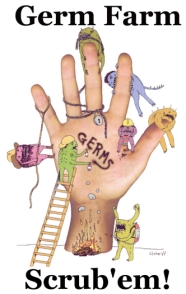Nobody enjoys cleaning up after a vomit or diarrhea related accident, but if it’s not done correctly, you, your co-workers, or your customers could be exposed to norovirus. It only takes about 10 norovirus particles to produce a case of gastroenteritis, and one sin gle vomiting incident can release 300,000 or more of these viral particles into the environment. And perhaps worst of all, not all disinfectants are effective at destroying norovirus. If surfaces that become contaminated with vomit or diarrhea are not disinfected properly, norovirus can survive for several days or even weeks!
gle vomiting incident can release 300,000 or more of these viral particles into the environment. And perhaps worst of all, not all disinfectants are effective at destroying norovirus. If surfaces that become contaminated with vomit or diarrhea are not disinfected properly, norovirus can survive for several days or even weeks!
In an effort to stop norovirus in its tracks, the State Environmental Health Office has provided several resources that can be used to help assure the effective cleanup of contaminated surfaces during these events. These resources, including a sample clean-up procedure, a corresponding color poster, and a list of EPA registered disinfectants that are effective against norovirus, can be found in the Food Service FAQs located here:
Please take some time to review your own cleanup protocol to make sure that it’s strong enough to tackle norovirus!
 In one trip to the restroom, a food worker infected with Norovirus may shed up to 1 trillion viral particles in 1 gram of stool; yet, it only takes as few as 10 viral particles to spread Norovirus to someone else. This is one of the reasons why Employee Health is an important part of food safety and illness prevention and is emphasized in our Rules and Regulations for Food Service [511-6-1-.03(4) ]. The new Rules and Regulations require that food service owners and operators be able to provide proof that they have informed conditional and established food workers of the reporting requirements associated with their personal health. You may access documents to assist you with your Employee Health Policy compliance at the Food Service FAQs located
In one trip to the restroom, a food worker infected with Norovirus may shed up to 1 trillion viral particles in 1 gram of stool; yet, it only takes as few as 10 viral particles to spread Norovirus to someone else. This is one of the reasons why Employee Health is an important part of food safety and illness prevention and is emphasized in our Rules and Regulations for Food Service [511-6-1-.03(4) ]. The new Rules and Regulations require that food service owners and operators be able to provide proof that they have informed conditional and established food workers of the reporting requirements associated with their personal health. You may access documents to assist you with your Employee Health Policy compliance at the Food Service FAQs located